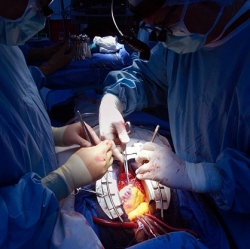
Pairing a donated organ with a potential recipient is a critical task requiring a near-perfect match. The necessity for such perfection is highly limiting, and for the thousands of Canadians waiting on transplant lists it can understandably diminish any hope of getting better or even surviving.
However, a study co-authored by Vancouver Coastal Health Research Institute scientist Dr. Caigan Du holds promise that in the future, the use of stem cells during the transplant process may eliminate the need for a perfect match.
Published in the October 2014 issue of Lung, Dr. Du and his colleagues’ study details use of a novel murine model and the intravenous delivery of mesenchymal stem cells (MSCs) to lung transplant recipients before transplantation to find whether MSCs could protect lungs from cold ischemia reperfusion injury (IRI).
Cold IRI is inevitable damage that happens to transplanted organs during two processes: first, when the donor organ is cooled and, second, when blood flow is returned once the organ is transplanted into the host’s body (i.e. reperfusion). IRI is a major cause of failure for newly transplanted lungs and immune cells are thought to mediate the injury that happens during reperfusion.
“With our work, we’re trying to reduce injury even before the organ has a chance to try functioning because that would allow for donated organs to be given to recipients who aren’t a perfect match,” says Dr. Du, an assistant professor in the Department of Urologic Sciences at the University of British Columbia.
